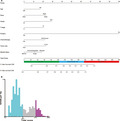- Record: found
- Abstract: found
- Article: found
A practical nomogram and risk stratification system predicting the cancer‐specific survival for patients with early hepatocellular carcinoma

Read this article at
Abstract
Background
Our purpose was to establish and validate a nomogram model in early hepatocellular carcinoma (HCC) patients for predicting the cancer‐specific survival (CSS).
Methods
We extracted eligible data of relevant patients between 2010 and 2015 from the Surveillance, Epidemiology, and End Results (SEER) database. Further, we divided all patients into two groups (training and validation cohorts) at random (7:3). Nomogram was established using effective risk factors based on univariate and multivariate analysis. The effective performance of nomogram was evaluated using concordance index (C‐index), calibration plots, decision curve analysis (DCA), and receiver operating characteristic curve (ROC).
Results
We selected 3620 patients with early HCC including the training cohort (70%, 2536) and the validation cohort (30%, 1084). The nomogram‐related C‐indexes were 0.755 (95% CI: 0.739–0.771) and 0.737 (95% CI: 0.712–0.762), in the training and validation cohorts, respectively. The calibration plots showed good consistency of 3‐and 5‐year CSS between the actual observation and the nomogram prediction. The 3‐, 5‐year DCA curves also indicated that the nomogram has excellent clinical utility. The 3‐, 5‐year area under curve (AUC) of ROC in the training cohort were 0.783, 0.779, respectively, and 0.767, 0.766 in the validation cohort, respectively. With the establishment of nomogram, a risk stratification system was also established that could divide all patients into three risk groups, and the CSS in different groups (i.e., low risk, intermediate risk, and high risk) had a good regional division.
Abstract
Our purpose was to establish and validate a nomogram model in early hepatocellular carcinoma (HCC) patients for predicting the cancer‐specific survival (CSS). We developed a practical nomogram in early HCC patients for predicting the CSS, and a risk stratification system follow arisen, which provided an applicable tool for clinical management.
Related collections
Most cited references33
- Record: found
- Abstract: found
- Article: not found
Global Cancer Statistics 2018: GLOBOCAN Estimates of Incidence and Mortality Worldwide for 36 Cancers in 185 Countries
- Record: found
- Abstract: found
- Article: not found
Nomograms in oncology: more than meets the eye.
- Record: found
- Abstract: not found
- Article: not found
